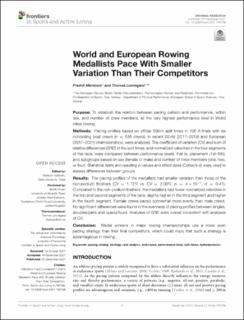| dc.contributor.author | Mentzoni, Fredrik | |
| dc.contributor.author | Losnegard, Thomas Johansen | |
| dc.date.accessioned | 2022-03-22T20:58:35Z | |
| dc.date.available | 2022-03-22T20:58:35Z | |
| dc.date.created | 2022-01-05T12:36:25Z | |
| dc.date.issued | 2021 | |
| dc.identifier.citation | Frontiers in Sports and Active Living. 2021, 3, Artikkel 790198. | en_US |
| dc.identifier.issn | 2624-9367 | |
| dc.identifier.uri | https://hdl.handle.net/11250/2986916 | |
| dc.description | This is an open-access article distributed under the terms of the Creative Commons Attribution License (CC BY). The use, distribution or reproduction in other forums is permitted, provided the original author(s) and the copyright owner(s) are credited and that the original publication in this journal is cited, in accordance with accepted academic practice. No use, distribution or reproduction is permitted which does not comply with these terms. | en_US |
| dc.description.abstract | Purpose: To establish the relation between pacing pattern and performance, within sex, and number of crew members, at the very highest performance level in World class rowing.
Methods: Pacing profiles based on official 500 m split times in 106 A-finals with six contesting boat crews (n = 636 crews), in recent World (2017–2019) and European (2017–2021) championships, were analyzed. The coefficient of variation (CV) and sum of relative differences (SRD) of the split times, and normalized velocities in the four segments of the race, were compared between performance levels, that is, placement (1st–6th), and subgroups based on sex (female or male) and number of crew members (one, two, or four). Statistical tests and resulting p-values and effect sizes (Cohen's d) were used to assess differences between groups.
Results: The pacing profiles of the medallists had smaller variation than those of the non-podium finishers (CV = 1.72% vs. CV = 2.00%; p = 4 × 10−7, d = 0.41). Compared to the non-podium finishers, the medallists had lower normalized velocities in the first and second segments of the race, slightly higher in the third segment and higher in the fourth segment. Female crews paced somewhat more evenly than male crews. No significant differences were found in the evenness of pacing profiles between singles, doubles/pairs and quads/fours. Analyses of SRD were overall consistent with analyses of CV.
Conclusion: Medal winners in major rowing championships use a more even pacing strategy than their final competitors, which could imply that such a strategy is advantageous in rowing. | en_US |
| dc.language.iso | eng | en_US |
| dc.subject | endurance | en_US |
| dc.subject | hydrodynamics | en_US |
| dc.subject | pacing | en_US |
| dc.subject | performance level | en_US |
| dc.subject | race analysis | en_US |
| dc.subject | rowing | en_US |
| dc.subject | split times | en_US |
| dc.subject | strategy | en_US |
| dc.title | World and European rowing medallists pace with smaller variation than their competitors | en_US |
| dc.type | Peer reviewed | en_US |
| dc.type | Journal article | en_US |
| dc.description.version | publishedVersion | en_US |
| dc.rights.holder | © 2021 Mentzoni and Losnegard | en_US |
| dc.source.pagenumber | 10 | en_US |
| dc.source.volume | 3 | en_US |
| dc.source.journal | Frontiers in Sports and Active Living | en_US |
| dc.identifier.doi | 10.3389/fspor.2021.790198 | |
| dc.identifier.cristin | 1975075 | |
| dc.description.localcode | Institutt for fysisk prestasjonsevne / Department of Physical Performance | en_US |
| dc.source.articlenumber | 790198 | en_US |
| cristin.ispublished | true | |
| cristin.fulltext | original | |
| cristin.qualitycode | 1 | |
